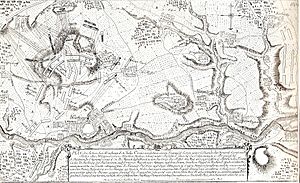George Howard (British Army officer) facts for kids
Quick facts for kids
Sir
George Howard
|
|
|---|---|

Portrait of Sir George Howard
|
|
| Born | 17 June 1718 |
| Died | 16 July 1796 (aged 78) Grosvenor Square, London |
| Buried |
Great Bookham, Surrey
|
| Allegiance | |
| Service/ |
|
| Years of service | 1736–1796 |
| Rank | Field Marshal |
| Commands held | 3rd Regiment of Foot |
| Battles/wars | War of the Austrian Succession Jacobite Rebellion Seven Years' War |
| Awards | Knight Companion of the Order of the Bath |
Field Marshal Sir George Howard was a British military officer and politician. He was born on June 17, 1718, and passed away on July 16, 1796. He led the 3rd Regiment of Foot in several important battles. These included the Battle of Fontenoy in 1745 during the War of the Austrian Succession. He also fought in the Jacobite Rebellion at the Battle of Falkirk Muir and the Battle of Culloden. Later, he commanded a group of soldiers at the Battle of Warburg during the Seven Years' War. Sir George Howard also served as the Governor of Minorca.
Military Career and Key Battles
George Howard was the son of Lieutenant General Thomas Howard. He went to Westminster School and Christ Church, Oxford. In 1736, he joined the army as a lieutenant. He became a captain in 1737. By 1739, he moved to the 3rd Regiment of Foot.
In 1744, he was promoted to lieutenant colonel. He then led the 3rd Regiment of Foot at the Battle of Fontenoy in May 1745. This battle was part of the War of the Austrian Succession.
Howard continued to lead his regiment in the Jacobite Rebellion. He fought under the Duke of Cumberland. They were at the Battle of Falkirk Muir in January 1746. Then, they fought at the Battle of Culloden in April 1746. After these battles, he returned to Europe. He fought at the Battle of Lauffeld in July 1747.
In 1749, he took over from his father as the colonel of the 3rd Regiment of Foot. He also took part in the Raid on Rochefort in September 1757. On January 24, 1758, he became a major-general. He led a brigade at the Battle of Warburg in July 1760. This was during the Seven Years' War. He was promoted to lieutenant-general on March 14, 1761.

Political Life and Later Years
In 1761, George Howard became a Member of Parliament (MP) for Lostwithiel. He was honored as a Knight Companion of the Order of the Bath in 1763. He also became the colonel of the 7th (The Queen's Own) Regiment of Dragoons in August 1763. He bought a country home called Stoke Place in Buckinghamshire in 1764.
Howard left Parliament in 1766. He then became the Governor of Minorca. After his time as governor, he became the governor of the Royal Hospital Chelsea in February 1768. That same year, he was elected as a Member of Parliament for Stamford.
On September 6, 1777, he was promoted to full general. In April 1779, he became the colonel of the 1st (The King's) Dragoon Guards. His highest rank was field marshal, which he achieved on October 18, 1793. He was also given the honorary role of Governor of Jersey in July 1795. Sir George Howard passed away at his home in Grosvenor Square, London, on July 16, 1796. He was buried in Great Bookham in Surrey.
Family Life
Sir George Howard married Lady Lucy Wentworth on February 16, 1747. She was the sister of William Wentworth, Earl of Strafford. They had one daughter named Anne. After Lady Lucy passed away, Sir George married Elizabeth Beckford. She was the widow of Thomas Howard, 2nd Earl of Effingham. They did not have any children together.


